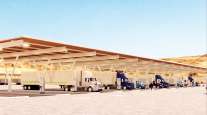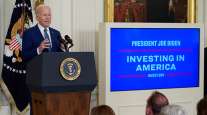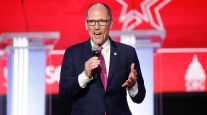Trump’s Plan Needs Mechanism to Steer Money to Infrastructure
Congressional Republicans have been reluctant to comment on — or even work on — legislation to deliver on President Donald Trump’s pledge to spend $1 trillion on infrastructure over 10 years.
Lawmakers say they’re waiting for the administration to provide details of a proposal that has raised more questions than it answered. Among the questions is how Trump would entice investors to put more than $150 billion in equity into infrastructure projects.
At the heart of Trump’s $1 trillion ambition — presented in an October paper by Trump advisers Wilbur Ross and Peter Navarro — is about $167 billion in equity capital. The document says Trump would encourage companies by offering an 82% tax break and it raises the prospect of what it calls “synergistic interaction” with a change in tax law to repatriate corporate profits held abroad. The equity would leverage additional debt to get to $1 trillion.
The staff of the Joint Committee on Taxation estimated in August 2016 that about $2.5 trillion in profits accumulated since 1986 are held abroad.
But companies that hold money abroad and could be enticed to repatriate that money under a new tax regime aren’t necessarily companies that are comfortable investing in infrastructure. Tax writers on Capitol Hill say the repatriation element would require the federal government to serve as a vehicle for infrastructure investment.
“I’m not quite sure how it would work,” Senate Finance Chairman Orrin G. Hatch, (R-Utah), said. “The federal government would have to take that over.”
Kevin Brady, (R-Texas), chairman of the House Ways and Means Committee, said it is “premature” to discuss a specific use of repatriated money other than as part of a tax overhaul.
In the House Republican tax plan, “we took those dollars and plowed them back into a lower rate and a more competitive tax system, which is where I believe it belongs,” Brady said. “Others would like to use it on infrastructure and have asked to have those discussions, so we certainly will, through the process. None of that has been discussed to my knowledge.”
Brady echoed the approach laid out in the “Better Way” plan that House Speaker Paul Ryan and other House Republican leaders rolled out last year, which calls for repatriation to be used to fill revenue gaps left by lowering tax rates. Ryan has also indicated he could be open to a tax overhaul that would include repatriation.
Sen. Mark Warner (D-Va.), a member of the Finance Committee, told CQ Roll Call that he and Rep. John Delaney (D-Md.) have proposals to establish an infrastructure bank that would be a vehicle to oversee repatriated funds. That tool would provide “concentrated expertise” for infrastructure investment and allow for long-term funding, including issuing bonds of up to 50 years, said Warner, a former venture capitalist.
A White House spokeswoman said in an e-mail that a plan was still being developed.
“The president is fully committed to finding the best plan to revitalize and reinvest in our nation’s crumbling infrastructure,” she wrote. “We are currently considering many options for that plan, and it would be premature to speak about specifics, especially while he’s still waiting to get some of his top leadership at the relevant agencies and departments in place.”
Aaron Klein, an economist at the liberal Brookings Institution, is skeptical.
“I don’t think there is a Trump infrastructure plan,” he said. “It’s been disappointing, to me at least, that we haven’t seen a concrete proposal. … I’m not sure anyone there has a concrete idea of what they want. The president obviously wants to be big and bold and transformative. Whether that’s a desire shared by other key people in the administration is unclear.”
Complicating the question of a mechanism to steer corporate profits into infrastructure investment are lawmakers’ goals regarding the deficit and distinctions about types of infrastructure that Trump wants to fund.
Ross and Navarro said in their October paper that the plan was deficit neutral.
“It says it would pay for itself,” said Michael Sargent, a research associate with the conservative Heritage Foundation. “I don’t think that’s realistic at all.”
The deficit-neutral projection rests on a “wildly optimistic” forecast that the tax revenue from construction jobs and general economic boost created by infrastructure spending would offset the spending itself, Sargent said. But that projection underestimated the income tax that construction workers already pay, Sargent said.
The projection also overestimated the rate at which construction wages would be taxed, said Adie Tomer, an economist and fellow with Brookings’ Metropolitan Policy Program. Ross and Navarro assumed slack in the construction labor market would allow companies to hire more workers, but data indicate that is not the case, Tomer said.
The president has included transportation, energy, broadband and even schools and hospitals in his list of infrastructure needs. The private sector already invests heavily into sectors such as energy and broadband, and owns the assets created.
Transportation infrastructure, by contrast, relies much more on government funding. Private investment in surface transportation infrastructure tends to come from specialized fund managers.
Infrastructure Investor, a publication that covers the industry, found the top 50 global infrastructure funds raised about $282 billion in the five years from 2011 to 2016. But that number encompasses funds raised for investment in non-transportation infrastructure.
Rep. Richard Neal of Massachusetts, the ranking Democrat on the Ways and Means Committee, wouldn’t bother with the private option. He would inject money from repatriation into the Highway Trust Fund, the federal government’s traditional vehicle for apportioning money to highway and transit programs.
The fund in recent years has received less revenue from fuel taxes than the government has decided to spend. The result has been transfers from the General Fund. Neal said tapping into repatriated money would add an estimated $200 billion to the Highway Trust Fund.
“Brought back at the proper rate, it would give us an inducement to do a pretty good down payment on infrastructure,” he said. “But it won’t be enough.”
Both Warner’s federal infrastructure bank and Neal’s proposal to use the Highway Trust Fund would involve Washington in decisions about where to spend it. Democrats are critics of Trump’s preference to rely on the private sector, saying it would favor projects with revenue and profit that can be forecast.
Ross and Navarro acknowledged as much in their paper last October. “It needs a revenue stream from which to pay operating costs, the interest and principal on the debt and the dividends on the equity,” they wrote.
Ross is now the nominee to lead the Commerce Department and Navarro is the head of a newly established National Trade Council. Neither post has an explicit infrastructure responsibility.
Transportation Secretary Elaine Chao has further muddied the water. Asked at her confirmation hearing whether she and Trump prefer an infrastructure plan that included direct spending, she said, “I believe the answer is yes.”
Key Senate Republicans from rural states, including John Thune of South Dakota and John Barrasso of Wyoming, said this month that investor-backed projects wouldn’t satisfy rural needs. Thune is chairman of the Commerce, Science and Transportation Committee and Barrasso is chairman of Environment and Public Works.
For the infrastructure authorizing committees, the many questions leave them with little to do.
Asked how much federal spending Republican congressional leaders might allow, House Transportation and Infrastructure Chairman Bill Shuster of Pennsylvania told CQ other matters had to be worked out before that was clear.
“We’re not even talking about that at this point,” Shuster said. “We’ve got to wait until the Ways and Means Committee starts to move with some tax reform. That’s where that’s all going to start to gel and sort of figure out where we’re going. We’ll be there talking to them, trying to figure it all out. Again, we’re still a ways away from that. It’s a work in progress. It’s moving a little slow.”
Shuster said Trump promised him money for infrastructure during a White House meeting on Feb. 16, according to a pool report. But the pledge lacked details.
Distributed by Tribune Content Agency, LLC




